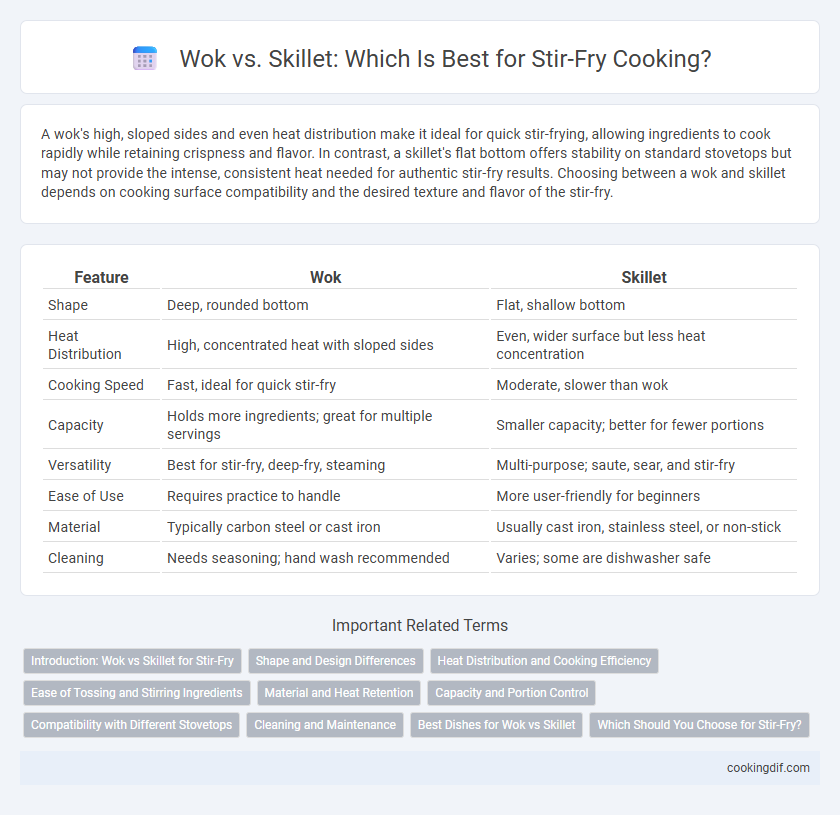A wok's high, sloped sides and even heat distribution make it ideal for quick stir-frying, allowing ingredients to cook rapidly while retaining crispness and flavor. In contrast, a skillet's flat bottom offers stability on standard stovetops but may not provide the intense, consistent heat needed for authentic stir-fry results. Choosing between a wok and skillet depends on cooking surface compatibility and the desired texture and flavor of the stir-fry.
Table of Comparison
| Feature | Wok | Skillet |
|---|---|---|
| Shape | Deep, rounded bottom | Flat, shallow bottom |
| Heat Distribution | High, concentrated heat with sloped sides | Even, wider surface but less heat concentration |
| Cooking Speed | Fast, ideal for quick stir-fry | Moderate, slower than wok |
| Capacity | Holds more ingredients; great for multiple servings | Smaller capacity; better for fewer portions |
| Versatility | Best for stir-fry, deep-fry, steaming | Multi-purpose; saute, sear, and stir-fry |
| Ease of Use | Requires practice to handle | More user-friendly for beginners |
| Material | Typically carbon steel or cast iron | Usually cast iron, stainless steel, or non-stick |
| Cleaning | Needs seasoning; hand wash recommended | Varies; some are dishwasher safe |
Introduction: Wok vs Skillet for Stir-Fry
A wok's high, sloping sides and round bottom create intense, even heat distribution ideal for fast stir-frying with minimal oil. In contrast, a skillet features a flat bottom and lower sides, providing stable contact with the heat source but less capacity for tossing ingredients. Choosing between a wok and skillet depends on stove type, cooking volume, and desired flavor intensity in stir-fry dishes.
Shape and Design Differences
A wok features a deep, rounded bottom and high sloping sides that enable rapid, even heat distribution and effortless tossing during stir-fry cooking. In contrast, a skillet has a flat, wide base with lower, straight sides that limit heat concentration and make stirring less fluid. The wok's distinctive shape is optimized for high-heat, quick-cooking techniques, whereas the skillet is better suited for searing and pan-frying with more surface contact.
Heat Distribution and Cooking Efficiency
A wok's curved shape ensures rapid and even heat distribution, allowing ingredients to cook quickly at high temperatures with minimal oil. In contrast, a skillet's flat surface provides stable heat but often results in uneven cooking, especially when tossing or stirring ingredients. Woks excel in cooking efficiency by maintaining consistent high heat, making them ideal for traditional stir-fry techniques.
Ease of Tossing and Stirring Ingredients
A wok's deep, sloped sides provide superior ease of tossing and stirring ingredients, allowing for quick and even cooking with minimal spillage. In contrast, a skillet's shallow, flat design limits tossing motion, making it harder to consistently stir-fry without potential ingredient spillover. The wok's high heat retention and shape facilitate rapid, uniform cooking, optimizing stir-fry techniques.
Material and Heat Retention
Carbon steel woks offer superior heat retention and rapid temperature changes essential for high-heat stir-frying, making them ideal for achieving the characteristic sear and flavor. Cast iron skillets retain heat well but heat more slowly and are heavier, which can affect maneuverability and even heat distribution during quick stir-fry cooking. Stainless steel skillets heat evenly but lack the intense heat retention of carbon steel woks, impacting the ability to maintain high temperatures required for authentic stir-fry techniques.
Capacity and Portion Control
Woks offer greater capacity and superior heat distribution, making them ideal for cooking large portions of stir-fry evenly without overcrowding. Skillets generally have limited depth and surface area, which may restrict ingredient volume and affect portion control by requiring multiple batches. Choosing a wok enhances efficiency and consistency in preparing generous stir-fry servings.
Compatibility with Different Stovetops
Woks feature a rounded bottom ideal for gas stovetops, allowing high heat distribution and rapid cooking, but may require a wok ring on flat electric or induction stovetops for stability. Skillets have flat bottoms that provide direct contact with electric and induction stovetops, ensuring even heating and compatibility without additional accessories. Understanding stovetop type is essential for choosing between a wok and skillet to optimize stir-fry performance and heat efficiency.
Cleaning and Maintenance
Woks, typically made of carbon steel, require seasoning to maintain their non-stick surface and prevent rust, making cleaning a quick rinse with hot water essential to preserve the seasoned layer. Skillets, often non-stick or cast iron, vary in maintenance; non-stick skillets need gentle hand washing to avoid damaging the coating, while cast iron skillets also benefit from regular seasoning like woks. Proper cleaning and maintenance extend the lifespan of both cookware types, ensuring optimal performance for stir-frying tasks.
Best Dishes for Wok vs Skillet
Woks excel in high-heat, fast-cooking dishes like classic stir-fried vegetables, fried rice, and quick seared meats due to their curved shape and even heat distribution. Skillets are ideal for dishes requiring more surface contact and moderate heat, such as sauteed vegetables, pan-seared chicken, or thicker cuts of meat. The wok's ability to toss ingredients rapidly makes it perfect for delicate, bite-sized pieces, while skillets offer controlled browning for larger, evenly cooked portions.
Which Should You Choose for Stir-Fry?
A wok's high, sloped sides provide superior heat distribution and allow for effortless tossing, making it ideal for authentic stir-fry techniques that require quick, even cooking. A skillet offers a flat bottom and greater surface area, which can be beneficial for searing and cooking larger quantities but may result in less efficient heat circulation. Choosing between a wok and a skillet depends on whether you prioritize the traditional rapid stir-fry method or versatility for other cooking styles.
Wok vs Skillet for stir-fry Infographic

 cookingdif.com
cookingdif.com